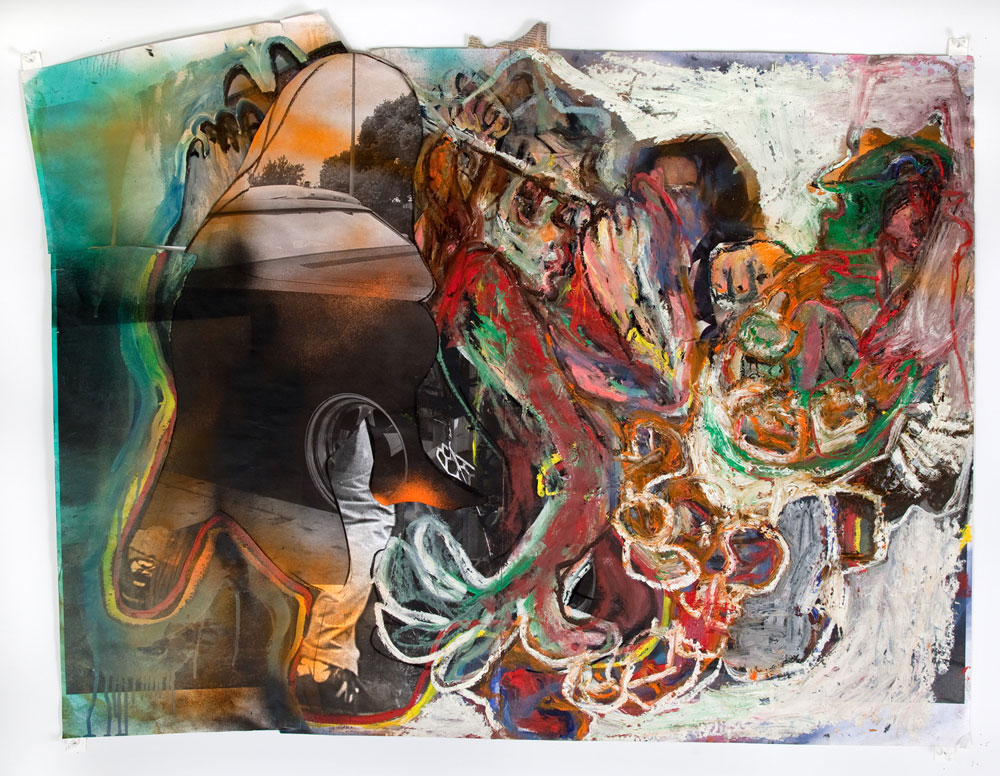Rita Ackermann and Harmony Korine’s Shadowland

PHOTO COURTESY OF THE ARTISTS/SWISS INSTITUTE
Both Harmony Korine and Rita Ackermann have accomplished a lot in their relatively short careers, creating seminal works in film and painting, respectively. The paintings and collages in their first collaborative effort, Shadow Fux, reflect their personalities and mutual respect for one another. Consisting of large-scale paintings on vinyl and canvas, drawings, and two films, the show abstractly reinterprets some of the imagery from Korine’s 2009 film release, Trash Humpers, skewing any sense of narrative residue from the film and overlapping it with a new sense of mischief and monument.
We chatted with Harmony over the phone, discussing burglary, Rita Ackermann and Nashville.
ADAM O’REILLY: Where are you right now?
HARMONY KORINE: I am in Nashville. I’ve been trying to set these traps to catch this fucker, a burglar.
O’REILLY: What kind of burglar?
KORINE: This guy is stealing a bunch of these statues, what are they called… lawn jockeys, out of my yard. We’ve been setting up these traps trying to electrocute the mother fucker.
O’REILLY: Have you and Rita Ackermann been friends for a while?
KORINE: We’ve been friends for over 15 years, I think.
O’REILLY: Is collaboration a new thing for the two of you?
KORINE: We’ve always played around or collaborated informally, made little paintings together, but this the first time we’ve been able to actually do it and show it to people.
O’REILLY: Did you both decide to work from the Trash Humpers film stills?
KORINE: Some of the images that started out as a base for the collages were from before Trash Humpers, photos that inspired the film. I would sculpt these really crude masks that resembled a burnt marshmallow face. We would go out at night, into the alleyways by my house, and I would take photos of my friends or assistants fornicating with trash and committing acts of vandalism. And then the paintings came from when Rita had seen these pictures, and just started talking about it, and we thought it was a really great idea. She’s one of my favorite painters in the world, one of the best, it was really exciting to do this project with her.
O’REILLY: Were you both working on the same surface?
KORINE: I would take these photos and I would enlarge them onto vinyl pieces and would send them to her, she would start to work over them, and we would talk about things and go back and forth.
O’REILLY: She was in New York when you were collaborating?
KORINE: Yes, or sometimes she would fly down here or I would go up there. It was mostly done separately, but at the same time together—we never wanted them to seem like a collaboration, more like one person, it was more about trying to create something or subject matter that was difficult to articulate.
O’REILLY: Was there a narrative involved in the paintings?
KORINE: No, not really, there wasn’t any story. When we started out, it was more like a feeling, we were both pretty in tune, more like trying to tap into something. We didn’t even talk or discuss it very much, it was more like a chemical reaction.
O’REILLY: Are you still working with the idea of Trash Humpers?
KORINE: No, no, that shit’s completely done. I might do Trash Humpers in Hawaii. [LAUGHS] You know, where the fuckers just surf everywhere, up and down, they screw all the sand dunes. No, I am going on to other things, I think of the paintings separately. They are connected to Trash Humpers, but they are their own thing.
O’REILLY: What are you working on now?
KORINE: I just directed this short movie, it’s going to come out soon, with this band called Die Antwoord from South Africa, that should probably be out in a couple weeks. It’s going to be spectacular.
O’REILLY: Any new books?
KORINE: A couple new books, a book of photographs, a book of little paintings, and I did this book that is going to come out soon that is all Ebonic poetry. You know?
O’REILLY: How so?
KORINE: I don’t want to give it away. It’s almost done, but if you can imagine the greatest poet of all time writing in Ebonics, that’s what it would be like.
O’REILLY: Who’s putting that out?
KORINE: I don’t know. I have a couple people who want to put it out. I am trying to get all that shit together. Sometimes it’s difficult, my mind moves so quickly, it confuses me, you know what I mean?
O’REILLY: Yes, for sure.
KORINE: It all just seems so perfect sometimes. That’s why I set traps for these fuckers, cause they don’t know that when you steal something, like a statue, you’re not just stealing from me, you’re stealing from God, and I will electrocute your ass. [LAUGHS]
O’REILLY: It’s confusing, getting things stolen. It can throw you off your game.
KORINE: It’s also, they’re so beautiful, like, so beautiful.
O’REILLY: What kind of statues are they?
KORINE: They were just these things I found in a flea market, but I know they were probably made by some guy who was great—like a sharecropper who had been lobotomized at one point, but had really, really good sculpture skills. I thought they were all leprechauns when I got them, but somebody told me they were lawn jockeys.
O’REILLY: What do you spend your days in Nashville doing?
KORINE: Hang out. I have a baby, sometimes we go for walks, or I got out to the firing range, or drive around in the car, listen to rap music, eat pimento cheese sandwiches. Daydream.
SHADOW FUX IS ON VIEW AT THE SWISS INSTITUTE THROUGH JANUARY 23, 2011. FIND OUT MORE ABOUT THE EXHIBITION HERE.






